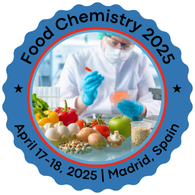About Conference
Conference Series LLC ltd with immense pleasure invites all the contributors across the globe to the 8th international conference on food chemistry, nutrition and safety during April 17-18, 2025 Madrid, Spain, focusing on the theme “Shaping the Future of Food Quality, Health & Safety ”Which includes prompt keynote presentations, Oral talks, Poster presentations and Exhibitions.
This Food Chemistry 2025 conference will focus on the theme “Shaping the Future of Food Quality, Health & Safety”. So this is a valuable and important platform for inspiring international and interdisciplinary exchange of food and nutrition research. This food conference will focus on chemical components of food, their nutritional, sensory, flavour, microbiological and physiological aspects; changes in chemical and biochemical composition and structure during processing, transportation and storage; chemical aspect of food safety and quality, other by-products, and processing wastes; chemistry of agro-chemicals, food additives and contaminants, along with their metabolism and toxicology, etc.
The Food Chemistry Conference will bring together academicians, chemists, scientists, dieticians, nutritionists, engineers, technologists from all over the world to exchange their knowledge and experience on food and nutrition research. We hope you will join us at Montreal, Canada for a fantastic networking experience.
The development of colleges and universities worldwide, most notably in the United States, would expand food chemistry with research of the dietary substances, most notably the Single-grain experiment during 1907-1911. Additional research by Harvey W. Wiley at the United States Department of Agriculture during the late 19th century would play a key factor in the creation of the United States Food and Drug Administration in 1906. The American Chemical Society would establish their Agricultural and Food Chemistry Division in 1908 while the Institute of Food Technologists would establish their Food Chemistry Division in 1995.
What’s new?
The Food Chemistry, Nutrition and Safety has moreover set itself the undertaking of working on numerous levels to set up activities gone for improving collaborations between researchers in fundamental and clinical research and to encourage interdisciplinary research exercises. On an instructive level, the exploration bunch goes for supporting the training and direction of youthful researchers by giving amazing preparing chances to PhD understudies and postdoctoral colleagues. It additionally gives a chief interdisciplinary stage to specialists, professionals and teachers to display and talk about the latest developments, patterns, and worries and in addition useful difficulties experienced and arrangements embraced in the fields of Current Trends in Food Chemistry, Nutrition and Safety.
Why to attend ?
With members from around the world focused on learning about The Food Chemistry, Nutrition and Safety and its advances; this is your best opportunity to reach the largest assemblage of participants from the Food Chemistry, Nutrition and Safety and its allied areas. Conduct presentations, distribute information, meet with current and potential scientists, make a splash with new drug developments, and receive name recognition at this 2-day event. World-renowned speakers, the most recent techniques, developments, and the newest updates in The Food Chemistry, Nutrition and Safety.
Benefits Food Chemistry 2025:
-
Abstracts that are accepted will be published with a DOI in Journal of Nutrition and Food Sciences.
-
International collaboration: When exchanging and trading ideas
-
A Special Chance for Sponsors and Advertisers at This International Conference
-
Stay current on developments in your field's research
-
Develop as a presenter and researcher
-
Request input on your research.
-
Get to know your peers by meeting them.
-
Become more visible in your industry
-
Share the results of your research with experts in your field.
-
Keep up with subjects and trends.
-
Encourage innovation and creativity in the business world.
TARGET AUDIENCE
-
Clinical nutritionists
-
Food technology researchers
-
Nutrition associations and societies
-
Scientists
-
Researches
-
Dietitians
-
Students
-
Quality control officers
-
Quality assurance officers
-
Food engineers
-
Business entrepreneurs
-
Industry professionals
-
Public health professionals
-
Fitness professionals
-
Pharmacists
-
Diabetes health professionals
Session and Tracks
Track 1: Chemistry of Food
Nourishment science is the examination of engineered strategies and participation of the natural and non-organic pieces of sustenance's. It covers with natural science in that it deals with the pieces of sustenance, for instance, sugars, lipids, proteins, water, nutrients, and dietary minerals. Moreover, it incorporates the examination and improvement of sustenance included substances that can be used to shield the idea of sustenance or to modify its concealing, flavor, and taste. It is, therefore, solidly associated with sustenance dealing with and status methodologies. There is, regardless, an advancing exchange about the prosperity effects of different sustenance added substances.
Track 2: Technology in Food Chemistry
Nourishment Technology is a piece of sustenance science that plans with the creation structure that make sustenance's. Early sensible assessment into sustenance advancement concentrated on sustenance shielding. Nicolas Appert's headway in 1810 of the canning technique was a conclusive event. The methodology wasn't called canning by then and Appert didn't in any way shape or form know the rule on which his strategy worked, yet canning has significantly influenced sustenance assurance strategies.
Louis Pasteur's examination on the deterioration of wine and his depiction of how to stay away from waste in 1864 was an early endeavor to apply logical information to nourishment dealing with. Other than examination into wine waste, Pasteur explored the generation of liquor, vinegar, wines and lager, and the souring of drain. He created sanitization—the way toward warming milk and drain items to crush sustenance deterioration and ailment delivering living beings. In his investigation into sustenance innovation, Pasteur turned into the pioneer into bacteriology and of current preventive pharmaceutical.
Track 3: Food Processing, Preservation and Packaging
Nourishment preparing is the difference in agrarian things into sustenance, or of one sort of sustenance into various structures. Sustenance getting ready joins various kinds of dealing with sustenance's, from pounding grain to make unrefined flour to home cooking to complex current methods used to make comfort nourishments. Essential sustenance taking care of is critical to make most sustenance's tasteful and discretionary sustenance taking care of changes the fixings into conspicuous sustenance's, for instance, bread. Tertiary sustenance getting ready has been examined for progressing over sustenance and strength, containing too much sugar and salt, too little fiber, and by and large being unhealthful.
Track 4: Food safety, security and Sustainability
Nourishment security is a condition related to the openness of sustenance, and individuals' accessibility and moderateness to it. There is evidence of being utilized over 10,000 years back, with central specialists in improvements outdated China and old Egypt being known to release sustenance from limit amidst starvation. At the 1974 World Food Conference the articulation "sustenance security" was portrayed with a complement on supply. Sustenance security, they expressed, is the "availability reliably of palatable, encouraging, contrasting, balanced and moderate world sustenance supplies of major groceries to keep up a suffering advancement of sustenance use and to adjust instabilities in progress and prices".[1] Later definitions added solicitation and access issues to the definition. The last report of the 1996 World Food Summit communicates that sustenance security "exists when all people, reliably, have physical and money related access to satisfactory, shielded and nutritious sustenance to meet their dietary needs and sustenance tendencies for a working and strong life.
Track 5: Food Analysis and Quality Control
Nourishment examination is the control dealing with the progression, application and examination of illustrative systems for portraying the properties of sustenance and their constituents. These demonstrative procedures are used to give information about a wide scope of traits of nourishment's. Quality control, or QC for short, is a system by which substances study the idea of all components connected with creation. ISO 9000 portrays quality control as "A bit of significant worth organization focused on fulfilling quality essentials. This philosophy puts an emphasis on three points of view (worshipped in rules, for instance, ISO 9001).Elements, for instance, controls, work organization, described and all around supervised procedures, execution and reliability criteria, and unmistakable evidence of records. Ability, for instance, data, aptitudes, experience, and capacities Soft parts, for instance, work power, trustworthiness, assurance, definitive culture, motivation, solidarity, and quality associations. Audit is a critical piece of significant worth control, where physical thing is investigated ostensibly (or the last results of an organization are dismembered). Thing assessors will be given records and delineations of forbidden thing blemishes, for instance, breaks or surface defects for example.
Track 6: Recent Innovation in Food Chemistry
Diverse new customary and current progressions have been made to convey the capable nutritious sustenance and sustenance components for the prosperity sustenance subtleties. Late advancement in Food science accept the imperative employment in changing over the enhancement information related to the customer demands in sustenance things. To develop the sustenance with high heath regard without aggravating their flavor, surface, appearance a wide bunch sustenance dealing with and present day frameworks must be used. Nowadays various powerful endeavors in sustenance recovery have been performed for the cost minimization and improvement of sustenance things.
Track 7: Probiotics and Prebiotics
Nourishment science is the examination of engineered strategies and participation of the natural and non-organic pieces of sustenance's. It covers with natural science in that it deals with the pieces of sustenance, for instance, sugars, lipids, proteins, water, nutrients, and dietary minerals. Moreover, it incorporates the examination and improvement of sustenance included substances that can be used to shield the idea of sustenance or to modify its concealing, flavor, and taste. It is, therefore, solidly associated with sustenance dealing with and status methodologies. There is, regardless, an advancing exchange about the prosperity effects of different sustenance added substances.
Track 8: Food Waste Management, Public Health and Food Safety
Nourishment waste or sustenance adversity is sustenance that is discarded or lost uneaten. The explanations behind sustenance waste or setback are different and occur at the periods of making, dealing with, retailing and eating up. Overall sustenance adversity and waste signify somewhere in the range of 33% and one-bit of all sustenance conveyed. Mishap and wastage occur at all periods of the sustenance store system or regard chain. In low-wage countries, most setback occurs in the midst of age, while in made countries much sustenance – around 100 kilograms for each individual consistently – is wasted at the use organize.
Track 9: Nutraceuticals
Nutraceuticals is an expansive umbrella term that is utilized to portray any item got from nourishment sources with additional medical advantages notwithstanding the essential dietary benefit found in nourishments. A useful nourishment for one shopper can go about as a nutraceutical for another buyer. Instances of nutraceuticals incorporate invigorated dairy items (e.g., milk) and citrus natural products (e.g., squeezed orange. A few normally inferred nourishment substances have been contemplated in malignant growth treatments.
Track 10: Chemical Composition of Food and chemical Additives of Food
The differing kinds of emulsifier lecithin – powder, two unmistakable obsession liquids, granular and powder lecithin. Sustenance included substances can't avoid being substances added to sustenance to secure flavor or improve its taste, appearance, or changed attributes. A couple included substances have been used for an extensive period of time; for example, sparing sustenance by pickling (with vinegar), salting, in like manner with bacon, securing pastries or using sulfur dioxide comparatively similarly as with wines. With the happening to arranged sustenances in the second half of the twentieth century, various more included substances have been exhibited, of both trademark and phony reason. Sustenance included substances similarly consolidate substances that may be familiar with sustenance in an indirect manner (called "abnormal included substances") in the collecting strategy, through packaging, or in the midst of limit or transport.
Track 11: Food Microbiology and Its Toxicology
Nourishment microbiology is the examination of the microorganisms that thwart, make, or sully sustenance, including the examination of microorganisms causing sustenance rot, pathogens that may cause ailment especially if sustenance is improperly cooked or taken care of, those used to convey developed nourishment's, for instance, cheddar, yogurt, bread, ale, and wine, and those with other important employments, for instance, making probiotics.
Track 12: Biotechnology and Nanotechnology In Food
Nano-biotechnology, bio-nanotechnology, and Nano science are terms that insinuate the assembly of nanotechnology and science. Given that the subject is one that has recently created starting late, bio nanotechnology and Nano biotechnology fill in as spread terms for various related progressions. This request exhibits the merger of natural research with various fields of nanotechnology. Thoughts that are improved through Nano science include: Nano gadgets, (for instance, natural machines), nanoparticles, and Nano scale ponders that occurs inside the request for nanotechnology. This specific method to manage science empowers specialists to imagine and make systems that can be used for characteristic research. Normally energized nanotechnology uses natural structures as the inspirations for headways not yet made. Be that as it may, comparatively similarly as with nanotechnology and biotechnology, bio-nanotechnology has various potential good issues related with it.
Track 13: Chemical Fermentation Technology
Aging has been used for a significant long time to make sustenance things progressively rich and longer-persevering. Today it is moreover used as a handy alternative for the age of specific manufactured creations and sustenance fixings which are up 'til now being made with built, fossil-based techniques. Wageningen Food and Bio-based Research has a strong notoriety on development advancement for sustenance things and engineered mixes. With our uncommon lab-to-direct move toward we offer associations novel opportunities to find the most clever course to a given development process.
Track 14: Environmental Impacts on Food Production and Consumption
Nourishment creation contributes, for instance, to environmental change, eutrophication and corrosive downpour, just as the exhaustion of biodiversity. It is likewise an extensive channel on different assets, for example, supplements, land zone, vitality, and water. In Finland, around half of the measure of both phosphorus and nitrogen that winds up in the Baltic Sea because of human movement is inferable from horticulture. Cultivating strategies have advanced, and the utilization of manures has diminished significantly during the most recent couple of decades. Regardless of this, there has all the earmarks of being no lessening in supplement stacking owing to agribusiness. The Natural Resources Institute Finland is growing new answers for improving creation procedures, expanding the utilization of results, and limiting waste so as to decrease the supplement stacking inferable from generation. The point of the Natural Resources Institute Finland is to discover methods for relieving the ecological and climatic effects of nourishment creation.
Track 15: Food Adulteration
Food contamination is the procedure in which the nature of nourishment is brought down either by the expansion of substandard quality material or by extraction of important fixing. It not just incorporates the deliberate expansion or substitution of the substances yet natural and compound tainting amid the time of development, stockpiling, preparing, transport and circulation of the sustenance items, is likewise in charge of the bringing down or corruption of the nature of nourishment items. Adulterants are those substances which are utilized for making the nourishment items perilous for human utilization.
Track 16: Food authenticity and integrity
Food authenticity and integrity refers to the genuineness and intactness of food products. Food fraud is a major concern not only for consumers, but also for producers and distributors. . The food supply chain network has become very extensive, which increased its susceptibility to fraud. Today’s food products and ingredients may be sourced from a single farm or from producers and manufacturers worldwide. Labeling regulations exist to verify the authenticity and origins of these products as they are exported around the globe. Regrettably, recurring food contamination scandals show that there is always room for error, whether intentional, adulterated, or fraudulent.
Track 17: Organic chemistry
Organic chemistry is a branch of chemistry that studies the structure, properties and reactions of organic compounds, which contain carbon in covalent bonding. Study of structure determines their structural formula. Study of properties includes physical and chemical properties, and evaluation of chemical reactivity to understand their behavior. The study of organic reactions includes the chemical synthesis of natural products, drugs, and polymers, and study of individual organic molecules in the laboratory and via theoretical (in silico) study.
The range of chemicals studied in organic chemistry includes hydrocarbons (compounds containing only carbon and hydrogen) as well as compounds based on carbon, but also containing other elements, especially oxygen, nitrogen, sulfur, phosphorus (included in many biochemicals) and the halogens. Organometallic chemistry is the study of compounds containing carbon–metal bonds.
In addition, contemporary research focuses on organic chemistry involving other organometallics including the lanthanides, but especially the transition metals zinc, copper, palladium, nickel, cobalt, titanium and chromium.
Track 18: Food physical chemistry
Food physical chemistry is the branch of food chemistry which involves the physiochemical principles of the reactions and conversions that occur during the manufacture, handling, and storage of foods. Physical properties of food play a key role altogether fields wherever trendy technological processes are applied for the generation of food raw materials and therefore the production of food. The determination of physical properties of food and connected product are a pre-requisite for designing, production engineering and automation processes in today’s food, pharmaceutical and cosmetics industries furthermore as altogether connected internal control activities.
Track 19: Food Nanotechnology
Food nanotechnology is a zone of rising interest and opens up an entire universe of new conceivable outcomes for the sustenance business. Nanotechnology involves the manipulation of microscopic matter that ranges from 1 to 100 nm in size. Because food and water are naturally made up of particles that are on the nanometer scale, engineered nanoparticles are able to penetrate these products easily based on their similar properties. These particles can act as a whole unit by performing similar transportation functions that prove useful in almost every industry, particularly involving food products.
Track 20: New and rapid methods for food chemistry
Flow injection immunoassay, enzyme immunoassay, enzyme-linked immunosorbent assay, and other serological methods are known for their speed, high-throughput capacity, and possibility of precise quantification of the target, whereas conventional culture-based enumeration tests for the detection of microorganisms have become obsolete for real-time applications because they are labor-intensive and time-consuming. Even in chemical analysis, the development of quick and simple methods is starting to take precedence over time-consuming, traditional approaches. One of these sample preparation pre-treatment assays is based on the QuEChERS method, whose acronym encapsulates its benefits (quick, easy, cheap, effective, rugged, and safe). The work by Nagoya and Tölgyessy revealed the validation of a quick and easy approach for the detection of a subset of priority H2SO4 halogen contaminants (six polybrominated diphenyl ethers and eight organochlorines) in nine distinct fish species. It was stated how to prepare a modified Quenchers sample before performing a gas chromatography-triple quadruple tandem mass spectrometry study. The used method, in particular, demonstrated certain benefits in terms of simplicity, speed, and high extracts clean-up efficiency, and good sensitivity
Market Analysis
About:
Food Chemistry 2025 slated to be held on April 17-18, 2025 will be a great platform to showcase your research work in-front of most eminent researchers of Food and Nutrition. The conference is going to be hosted by the prestigious organization “Conferenceseries LLC LTD”
For developing nations, food, agriculture, and aquaculture are the most important sources for the national wealth. The market for food technology worldwide is predicted to be increasing significantly with a CAGR (Compound Annual Growth Rate) of 6.0%, reaching about $342.52 billion by the year 2027. In 2012, $27.1 billion was spent only on probiotic components and supplements globally. In 2013, that figure rose to $23.1 billion. By 2019 it has reached $220.32 Billion. Additionally, the processed food sectors, which include over 400,000 enterprises, are valued at over $2 trillion dollars globally. This growth is attributed to a number of factors such as suitable weather conditions, availability of natural resources and labor at a cheap salary. Additionally, due to developing trends in aquaculture, North America and Europe are anticipated to have a considerable growth in the near future.

The market for food flavors is estimated to be worth USD 14.30 billion in 2020 by 2021 that figure rose to $14.66 billion; by 2027, it is anticipated to increase by a CAGR of 4.64 percent to reach $20.12 billion. The report's main objective is to segment, define, and predict the size of the global market for food and beverage flavors based on factors such as use, type, form, origin, and geography.

The size of the global market for nutritional supplements is estimated at size of USD 155.2 billion in 2022; and it is projected to grow at a 7.3% CAGR to reach USD 220.8 billion by 2027. Most often the eating is done with a goal of increasing the body's intake of vital nutrients. Increased cardiovascular illnesses among the population brought on by erratic dietary habits and sedentary lifestyles among people between the ages of 30 to 40 are anticipated to highlight the value of nutraceuticals. The two biggest industrial centers on the planet are Europe and North America, which together account for the majority of the market for food flavors and enhancers. The European market is developed, and there are numerous regulatory organizations to strictly control the use of food flavors and enhancers, protecting many consumers from various countries. In 2019, the market for synthetic flavors was worth a $ 9.27 billion, while the market for natural flavors was worth just $ 3.74 billion.

The market for nutritional food was worth USD 5.40 billion in 2021 and was projected to grow to USD 11.08 billion by 2029, with a CAGR of 9.40 percent over the forecast period of 2022-2029. In-depth expert analysis, regulatory framework patient epidemiology, pricing analysis, pipeline analysis, and are all included in the market study put together by the Data Bridge Market Research team. It was expected to grow to USD 7.9 billion by 2026, with a CAGR of 8.3%. The market is heavily influenced by changing customer preferences, increasing health awareness, the number of millennial, and an increase in additional consumer income.
Throughout the few years, the Nutrition supplements market has seen a phenomenal spike in manufacture and sales. This has empowered various new Industries to dive into the business sector with goods that guarantee to be the remedy for youth, wellbeing, and essentialness. As directed by the Nutritional journals, the nutritional supplement market worldwide is valued at $155.2 billion in 2022 and expected to grow to $327.4 billion by 2030. The Global agricultural industry market size is expected to grow from $11.287 trillion in 2021 to $12.541 trillion in 2022. Global Food Export alone is estimated at around $8.66 trillion in 2022 according to the world trade organization. The cost of food varies in every region which makes it a bit difficult to learn about. It varies due to various factors like location, availability of Food industries, food transportation, storage and climate.
Food preservatives are widely used to prolong the shelf life of perishable foods and reduce food spoilage, ensuring that the nutritional content of the foods is maintained. Anti-microbial preservatives stop bacteria from growing, whereas antioxidant preservatives slow down lipid and vitamin content in fruit. Anti-enzymatic preservatives regulate enzymatic processes and prevent chemical enzymes from causing damage. Anti-enzymatic preservatives, for example, prohibit the fruits from ripening before harvesting. Chelating agents bind to trace metal ions, making antioxidant preservatives more efficient. Oils and fats, confectioneries, beverages, seafood, meat, poultry meals, snacks, dairy, frozen products, and other foods all use preservatives.
The global food preservatives industry is forecast to grow at a 3% CAGR from USD 2.6 billion in 2016 to USD 2.9 billion in 2021. The growing need for convenience foods and frozen foods with longer shelf lives has boosted the popularity of food preservative solutions. Preservative demand is expected to rise in response to the worries about consistency and safety requirements. Due to the increasing food and beverage manufacturing sector, cost advantages, raw material supply, China, Japan, and Australia are among the main regional markets targeted by food preservative manufacturers and distributors. This blog presents the broad physicochemical factors of food items and their global market strategies. Figure 1 depicts a flow diagram illustrating different product types, food spoilage processes, food preservation and manufacturing techniques, and a global industry overview of preserved foods.
Food Research Lab is a leading Food Consultants that supports to manufacture high quality and techno-economic feasible food products.

Figure 1: Summary of the research on the mechanisms and developments of food preservation and production [1]
Classification of foods
Foods can be divided into broad categories based on shelf life, functions, and nutritional content, as well as processing mechanisms (Fig. 2). Foods are divided into divisions depending on their shelf life. Food spoilage is a common occurrence in which food loses its colour, appearance, taste, nutritional value, and edibility over time. Food that has gone bad will cause sickness and, in the worst-case scenario, death. Food products may be graded as perishable, semi-perishable, or non-perishable based on their shelf life.

Figure 2: Classification of food [1]
Mechanism of food spoilage
Food preservation is related to food spoilage. Color, scent, taste, texture, or food may all be used to diagnose the early stages of food spoilage. Food spoilage is caused by human, microbial, or chemical behaviour. Since spoilage triggered by one mechanism may induce another, these mechanisms are not inherently mutually exclusive. The main causes of food spoilage are temperature, pH, air, nutrients, and the presence of various chemicals. Figure 3 depicts various factors that influence food spoilage.
 Figure 3: Important physical, microbial, and chemical factors that influence food spoilage [1]
Figure 3: Important physical, microbial, and chemical factors that influence food spoilage [1]
Food preservatives classification
Natural and synthetic preservatives are two types of food preservatives. Depending on the target food-spoiling agent, both natural and chemical/synthetic preservation additives may be labelled as anti-microbials, antioxidants, or chelators. Chemical preservatives are expected to hold a dominant market share due to their low expense, varied functionalities, and abundance; nevertheless, rising customer aversion and negative health consequences are among the major factors driving natural preservatives’ faster development.

Chemical preservatives
Preservatives are agents that hinder, retard, or stop the development of microorganisms, as well as any other degradation caused by their presence. Preservatives of food help to prolong the shelf life of certain foods. Preservatives prevent microorganisms from degrading food, allowing it to retain its colour, texture, and taste. Human and chemical food preservatives can be distinguished. Various chemicals found in animals, plants, and microorganisms may be used to protect food. They’re also antibacterial, vitamins, and flavourings. The roles of various natural reagents as food preservatives are mentioned in Table 1.
Table 1: Lists of natural preservatives [1]
|
Natural preservative
|
Example of food items
|
Functions
|
|
Salt Sugar
|
Salted fish Jam
|
Salt and sugar draw the water out of microorganisms and retard the growth of microorganisms.
|
|
Vinegar
|
Pickled mango
|
Vinegar provides an acidic condition which creates an unfavourable condition for microorganisms.
|
|
Rosemary extract
|
Mayonnaise, margarine, oils and fats, etc.
|
Rosemary extracts work as an antioxidant.
|
Food additives
The primary goals of using food additives are to boost and preserve nutritional value, improve efficiency, minimize waste, increase consumer acceptability, make food more accessible, and make food processing easier. Food additives are natural or synthetic chemical compounds deliberately added to foods during fermentation, preparation, or storage to achieve desired improvements in their properties. There are two types of food additives: deliberate and unintentional. The government specifically controls intentional additives. Table 2 lists the various forms of food additives as well as their potential uses.
Table 2: List of food additives [1]
|
Type of additive
|
Purpose
|
Example
|
|
Emulsifiers, stabilizers and thickeners
|
Impart a consistent texture to products; prevent separation of food
|
Algin, carrageenan
|
|
Anticaking agents
|
Enable products such as table salt to flow freely
|
Calcium silicate
|
|
Nutrients
|
Enrichment (replacement of nutrients lost during processing) and fortification (adding to the nutritional value of foods)
|
Folic acid, beta carotene, vitamin D,iron, iodine, etc.
|
|
Preservatives
|
Retard spoiling, prevent fats and oils from becoming rancid, prevent fresh food from turning brown
|
Nitrates, parabens, BHA, BHT, etc.
|
|
Leavening agents
|
Cause bread and baked goods to rise during baking
|
Sodium bicarbonate
|
|
Flavouring agents
|
Enhance the flavour of foods
|
Monosodium glutamate (MSG)
|
|
Sweeteners
|
Add sweetness with or without extra calories
|
Sucrose
|
|
Fat replacers
|
Impart texture, and creamy ‘mouth feel’ to food
|
Cellulose gel
|
Anti-microbial food preservatives
Anti-microbials primarily hinder or impede the development of microorganisms, thus preventing food spoilage. Compounds including calcium propionate and sorbic acid found in baked goods, salad dressings, cheeses, margarine, and pickled vegetables are examples of anti-microbial agents. Anti-microbials such as Naringenin producing Saccharomyces cerevisiae strain (a GRAS organism) [Naringenin, phenylacetaldehyde, phloretic acid and homogentisic acid] are also used as preservatives in the food industry to prolong shelf life, enhance product protection, sustain product consistency, lower production costs, and improve export goods internationally in diverse supply chains. Anti-microbials account for a considerable portion of the market due to their widespread use in various uses, including dairy and frozen foods, snacks, and convenience foods. One of the main factors of this segment’s development is consumer demand for packaged foods.
Preservatives for perishable products
Sodium nitrite is a primary preservative found in cured meats, sausage, and ground beef. When sodium nitrite is applied to meat or fish, it kills toxins and interacts with the proteins. Pathogens can be reduced by using solutions used by meat producers to increase shelf life and flavour. Meat preservatives are widely used because meat is a widely eaten food globally, with heavy use in major regions such as North America, Asia Pacific, Europe, and Latin America. In these areas, the economy is improving, allowing consumers to buy meat regularly.
North America is the leading market
The North American market for natural antioxidants is predicted to be the most robust between 2016 and 2022. The Asia Pacific market is expected to rise at the fastest pace. The growing demand for convenience foods is projected to affect the North American food preservatives industry significantly. Consumers are looking for convenience foods that are minimally processed and have a long shelf life. This has increased the need for suitable food safety initiatives in the field, prompting producers to look at newer innovations and additives that may be effective substitutes for synthetic preservatives.
Food Research Lab supports to select and find balance between ingredients and suggest for a flavourist for your product development.
Recent Developments
-
Galimax Flavor V-50, a new product from Galactic, was added to the market. It’s a preservative that can be seen in various salads, from pasta salads and potato salads.
-
In Belgium, Kemin has launched a new quality management lab, distribution, and logistics office. This aided the firm in providing quality service to its consumers by increasing the pricing of its goods.
-
Chemical Associates Inc.’s properties were bought by Univar (US). The strategic purchase was intended to help the company expand its market reach by targeting new market categories in the food, personal care, and other sectors. This would aid in the expansion of the company’s current product line in the United States.
-
The new technologies used to extend the shelf life of foods include irradiation, high-pressure food storage, and pulsed electric field effect. As dietary additives and preservatives, various chemical reagents have been added. However, there is increasing controversy over chemical additives and preservatives in food due to potential health risks.
Canada, Singapore and other European countries spend relatively less portion of their income on food while other equatorial countries like India, Pakistan and Africa spend relatively more portion of their income on food. The retail grocery industry in the US alone makes around $6.50 trillion in revenue in 2021 according to the U.S. Department of the census.
Leading Research Funders
International Societies and Associations
GLOBAL NUTRITION REPORT
Malnutrition is a universal issue holding back development with unacceptable human consequences and causing illness in the world population. Yet the opportunity to end malnutrition has never been greater. The UN Decade of Action on Nutrition 2016–2025 and the Sustainable Development Goals (SDGs) provide global and national impetus to address malnutrition and expedite progress. The burden of malnutrition across the world remains high, and progress remains slow. Malnutrition is one of the reasons for more ill health in the population than other causes. Children under five years of age face multiple burdens: 150.8 million are stunted, 50.5 million are wasted and 38.3 million are overweight. Meanwhile 20 million babies are born of low birth weight in every year. Overweight and obesity among adults are at record levels with 38.9%, stretching from Africa to North America, and increasing among adolescents. Women have a higher burden than men when it comes to certain forms of malnutrition: one third of all women of reproductive age have anemia and women have a higher prevalence of obesity than men. Millions of women are still underweight. Many countries are set to achieve the targets set by the global community to track progress on nutritional status to 2025.
VISA- TripAdvisor
Planning a Trip to Madrid, Spain !!! Attending Meeting!!!An issue with VISA!!
Food Chemistry 2025 Committee will be happy to help you in all regards to plan your trip to Madrid , Spain. Avail the official invitation letter from us to attend this event ahead with a closer step for approval of your VISA.
Find out what you need to do to visit Spain as a tourist or business person, how to extend your stay in Spain and what documents you need to carry with you to transit through Spain.
Application submission:
Spain does not have a visa office in every country so it is important that Delegates/Attendees visit the website of the visa office responsible for processing their visa applications. Information is available on the website on how to submit a visa application and the documentation required.
Delegates/Attendees are encouraged to submit their visa applications well in advance of the date of the event at a Visa Application Centre or on-line E-applications (e-Apps).
E-Apps
This system allows clients to submit applications online.
Delegates/Attendees that need a visa but require their passport for other travel purposes are strongly encouraged to submit their visa applications online (e-Apps). Delegates/Attendees that choose to apply online will not have to submit their passport until a decision has been taken on their applications. If required, the visa office will send the applicant instructions on how and where to send their passports to finalize the visa process.
Visa Application Centres (VACs):
VACs are commercial service providers authorized by Spain to provide specific services to applicants.
VACs provide a number of services including help applicants fill out forms, answer questions and ensure that applications are complete, thereby reducing unnecessary delays or refusals due to incomplete applications.
Applicants that are required to provide biometrics information as part of the visa application process can do so at a VAC. Additional information on the biometrics requirements is available at the IRCC website.
VACs send applications to Visa Offices and transmit decisions to applicants in a secure and confidential manner. VACs do not process visa applications and play no role in the decision-making process.
Visa Applications Processing Time:
Processing time for visa applications vary depending on the office and the time of the year. Participants should be encouraged to apply early for their visas, and to submit complete applications including all supporting documents.
Please visit the IRCC website for information on the time it takes to process visa applications at the various visa offices.
NEW - Electronic Travel Authorization (eTA)
As of March 15, 2016, visa-exempt foreign nationals are expected to have an Electronic Travel Authorization (eTA) to fly to or transit through Spain. Exceptions include U.S. citizens and travelers with a valid Spain visa. Spain citizens, including dual citizens, and Spain permanent residents are not eligible to apply for an eTA.
However, from March 15, 2016, until fall 2016, travellers who do not have an eTA can board their flight, as long as they have appropriate travel documents, such as a valid passport. During this time, border services officers can let travellers arriving without an eTA into the country, as long as they meet the other requirements to enter Spain. We invite you to consult the IRCC website regularly for information updates on eTA.
Best Tourist Destination: Madrid
-
Stanley Park
-
Granville Island
-
Grouse Mountain
-
Museum of Anthropology
-
Kitsilano Beach
-
Gastown
-
Canada Place
-
Chinatown
-
English Bay
-
Capilano Suspension Bridge
-
Robson Street
-
Museum of Vancouver
-
Queen Elizabeth Park
-
Science World
-
Richmond & Many more…

















